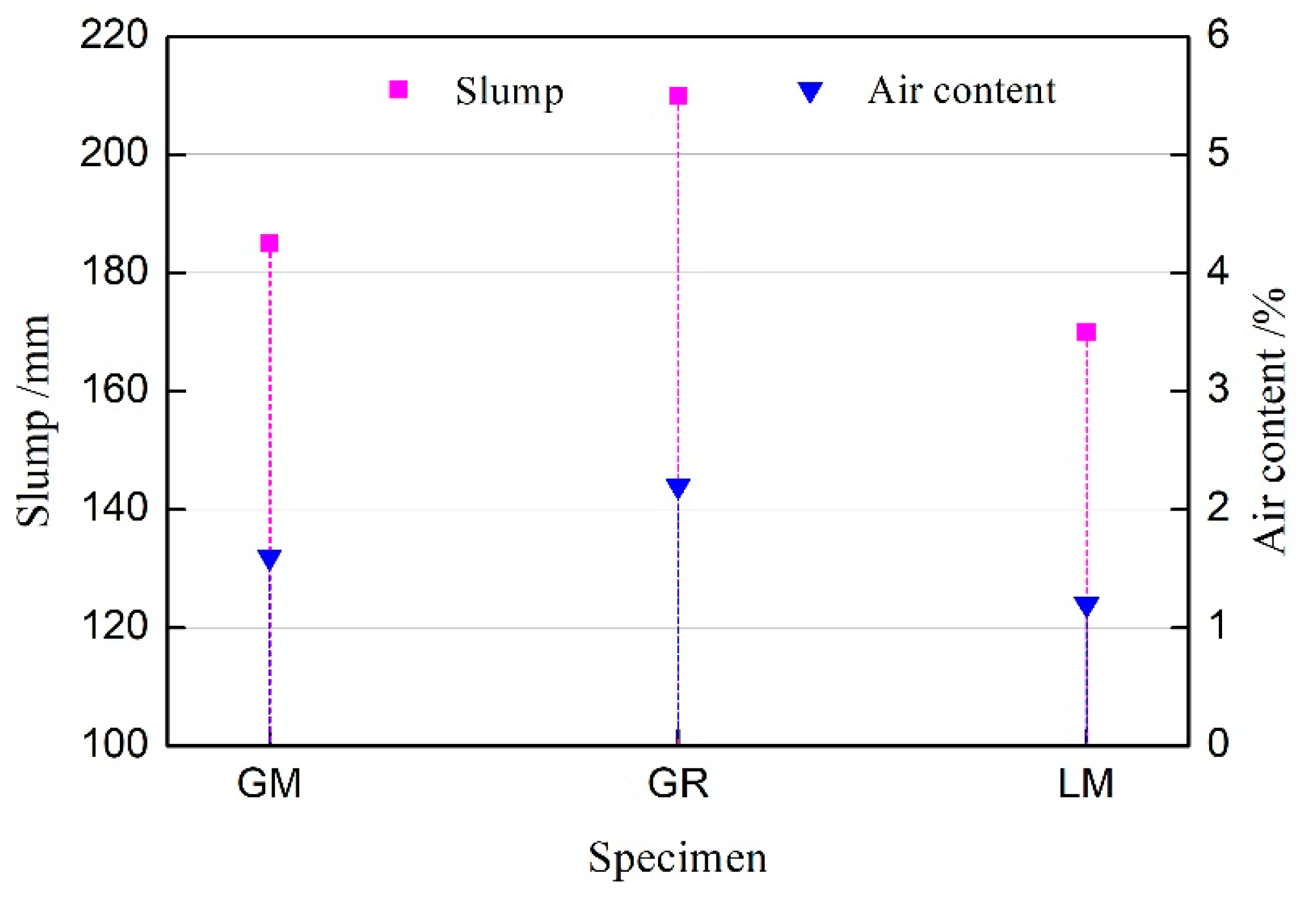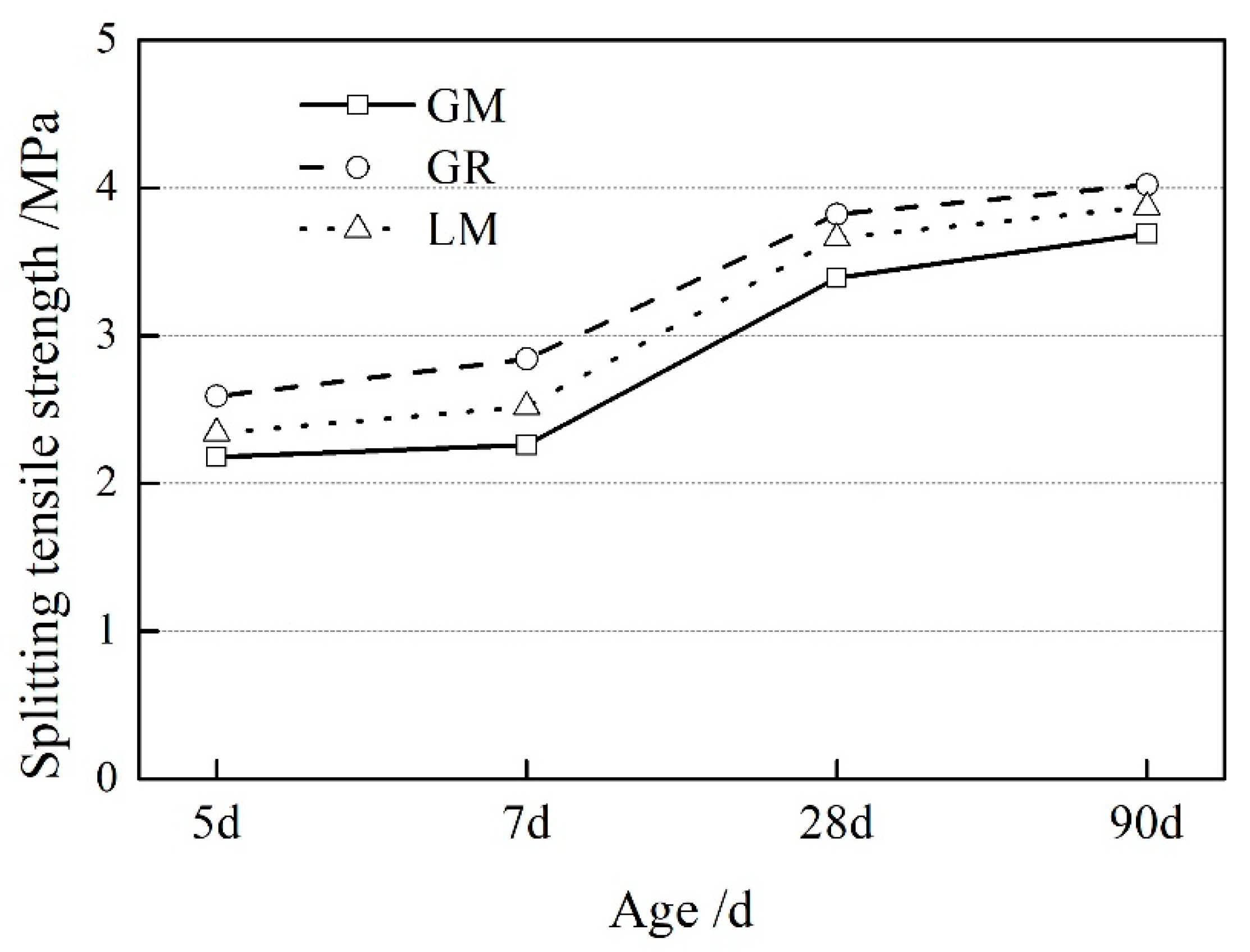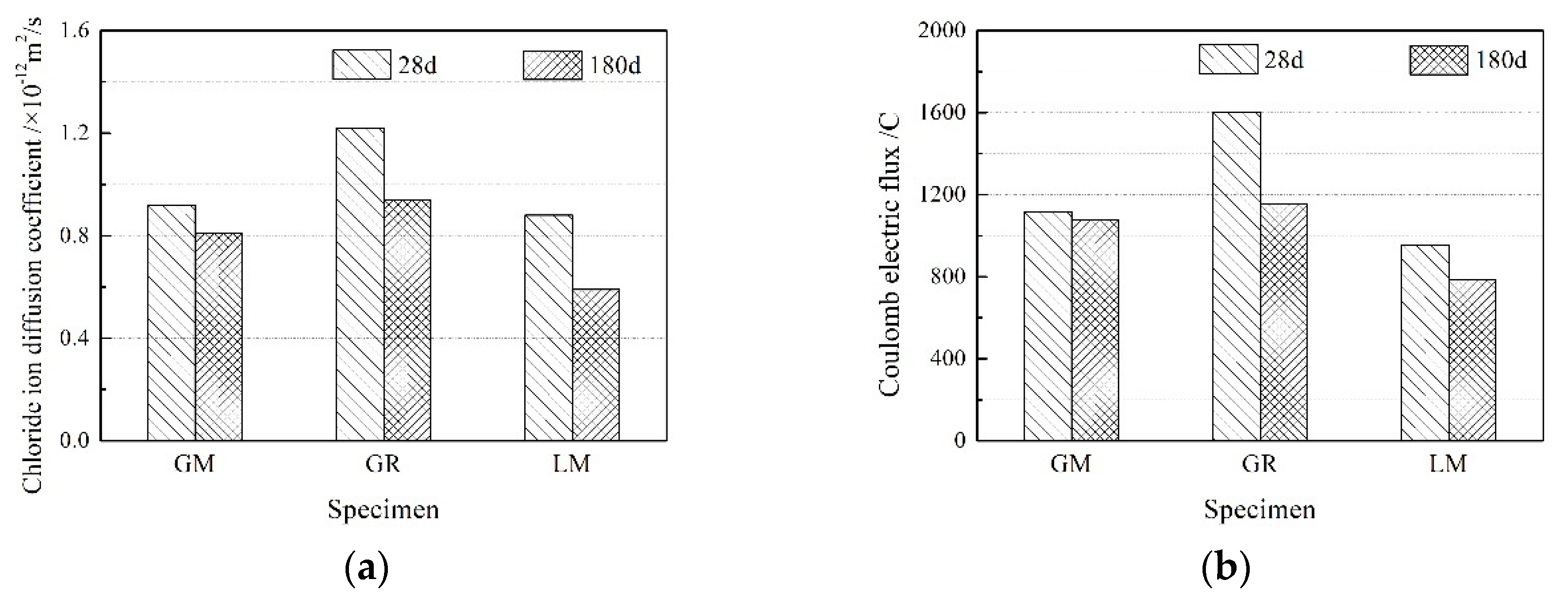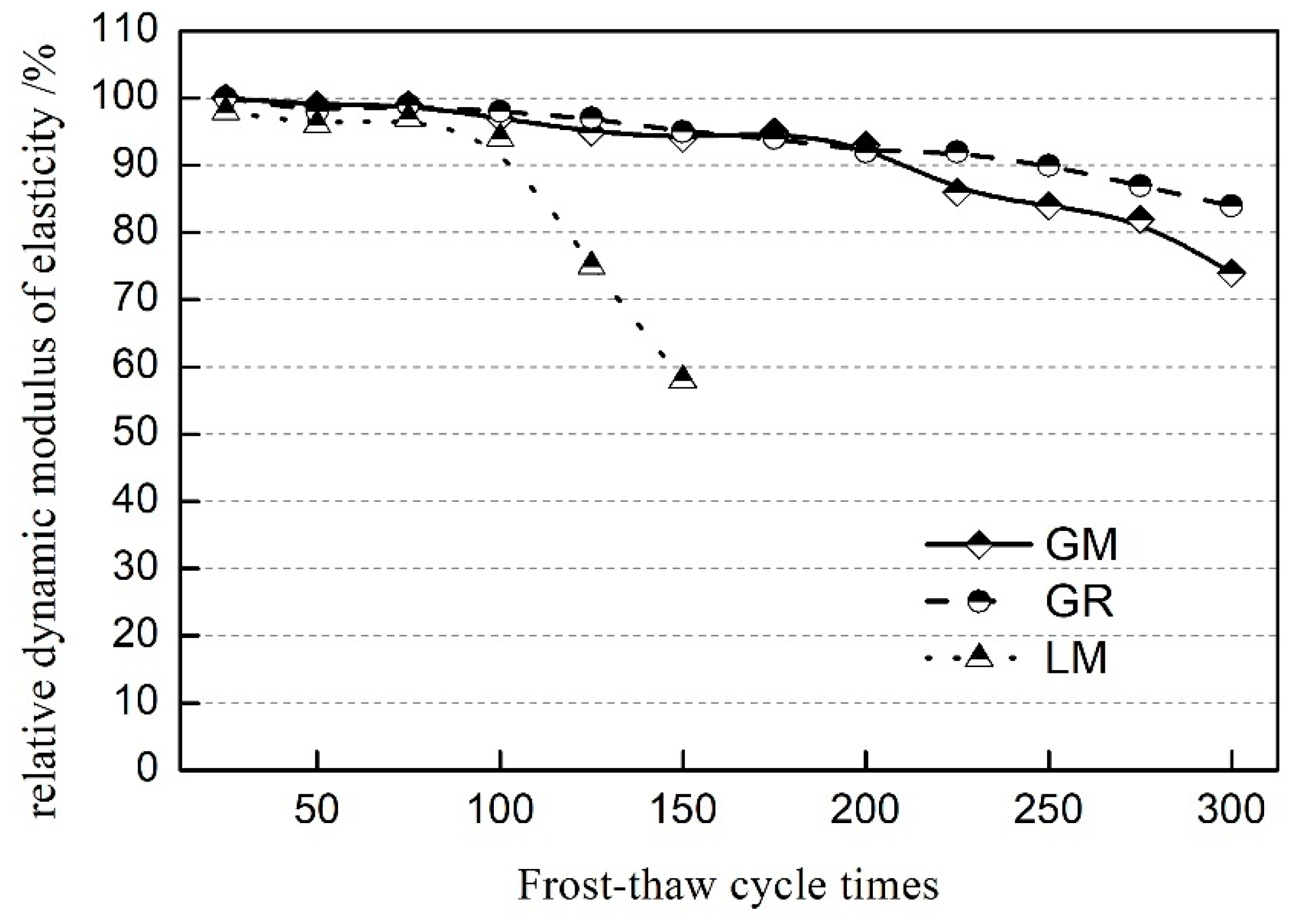Study on the Preparation and Properties of Bridge Concrete Using Low Carbon Aggregates
Abstract
1. Introduction
2. Materials and Methods
2.1. Materials
2.2. Mix Proportion
2.3. Test Method
2.3.1. Workability
2.3.2. Mechanical Properties
2.3.3. Chloride Ion Permeability Resistance
2.3.4. Freeze–Thaw Resistance
2.3.5. The Air-Void Parameters
- − Spacing factor L (mm).
- − Specific surface α (mm−1).
- − Air content A (%).
3. Results and Discussion
3.1. Workability
3.2. Mechanical Properties
3.3. Chloride Ion Permeability Resistance
3.4. Frost Resistance and Air-Void Parameters
4. Conclusions
- (1)
- Low carbon aggregates from tunnel muck affects the workability of fresh concrete through its characteristics and the changes in air content in fresh concrete. Therefore, the mix ratio should be optimized to obtain concrete prepared using low carbon aggregate with a better working performance in actual engineering applications.
- (2)
- The GM specimens show higher compressive strength. At 90 d, the compressive strength of GM was 14.6% higher than that of GR. The flexural strength of concrete prepared with manufactured sand is basically equivalent to that with natural sand. Compared to the GR specimens, the splitting tensile strength of GM decreased by 15%~20%. In addition, low carbon aggregates from tunnel muck reduces concrete’s elastic modulus because of the low elastic modulus of coarse granite aggregate; the elastic modulus of the GM specimens is 26.3% lower than those of LM at 5 d.
- (3)
- The ability to resist chloride ion penetration in concrete prepared using manufactured sand is better. Compared with river sand (GR), the electric flux and chloride ion diffusion coefficient of the specimens with granite manufactured sand (GM) decreased by 30% and 24.6%, respectively.
- (4)
- Concrete specimens with low carbon aggregates show better frost resistance properties. The concrete with the limestone aggregate (LM) could withstand the freeze–thaw cycle 150 times; however, the concrete samples with low carbon aggregates (GM or GR) could withstand the freeze–thaw cycle 300 times, indicating that low carbon aggregates can be used in special service environments.
- (5)
- In actual projects, low carbon aggregates prepared from tunnel muck can be used to prepare high-strength, high-performance, and durable concrete that meets the requirements of the project by controlling the quality of the granite manufactured sand and selecting a reasonable mix ratio.
Author Contributions
Funding
Institutional Review Board Statement
Informed Consent Statement
Data Availability Statement
Acknowledgments
Conflicts of Interest
References
- Li, H.; Huang, F.; Wang, Z.; Luo, X.; Yuan, Z.; Yi, Z.; Xie, Y. Review of material technology used in green railway tunnel engineering. Tunn. Constr. 2021, 41, 1992. [Google Scholar]
- Yuan, Z.; Huang, F.; Wang, Z.; Wen, J.; Yi, Z.; Li, H.; Xie, Y.; Yuan, J.; Li, H. Review on resources comprehensive utilization of tunnel muck in building materials. Bull. Chin. Ceram. Soc. 2020, 39, 2468. [Google Scholar]
- Chen, S.; Wu, D. Application of machine-made sand from tunnel slag in expressway construction. Highway 2017, 62, 249. [Google Scholar]
- Bellopede, R.; Marini, P. Aggregates from tunnel muck treatments. Properties and uses. Physicochem. Probl. Miner. Process. 2011, 47, 259–266. [Google Scholar]
- Gertsch, L.; Fjeld, A.; Nilsen, B.; Gertsch, R. Use of TBM Muck as Construction Material. Tunn. Undergr. Space Technol. 2000, 15, 379–402. [Google Scholar] [CrossRef]
- Bonavetti, V.; Donza, H.; Menéndez, G.; Cabrera, O.; Irassar, E.F. Limestone filler cement in low w/c concrete: A rational use of energy. Cem. Concr. Res. 2003, 33, 865–871. [Google Scholar] [CrossRef]
- Li, C.; Zhang, F.; Liu, L.; Ma, J.; Gen, T. Study of the effects of clay modifier on the properties of different mud concrete. Concrete 2015, 12, 56–59. [Google Scholar]
- Bao, G.; Xu, Q.; Zhang, L. Machine-made sand parameters and their influence on concrete performance. Eady-Mix. Concr. 2016, 10, 24–26, 38. [Google Scholar]
- Guo, D. Study of Maintechnical Requirements in High Quality Concrete Aggregate; Beijing University of Civil Engineering and Architecture: Beijing, China, 2016. [Google Scholar]
- Yue, H.; Li, B.; Zhou, M.; Liu, Z. Study and experiment of manufactured sand size grading for purpose of cement concrete. Concrete 2012, 3, 91–94. [Google Scholar]
- Guo, D.; Song, S.; Li, L. Influence of manufactured sand gradation of part II on mortar and concrete performance. Archit. Technol. 2016, 47, 829–831. [Google Scholar]
- Pilegis, M.; Gardner, D.; Lark, R. An investigation into the use of manufactured sand as a 100% replacement for fine aggregate in concrete. Materials 2016, 9, 440. [Google Scholar] [CrossRef] [PubMed]
- Westerholm, M.; Lagerblad, B.; Silfwerbrand, J. Influence of fine aggregate characteristics on the rheological properties of mortars. Cem. Concr. Compos. 2008, 30, 274–282. [Google Scholar] [CrossRef]
- Cortes, D.D.; Kim, H.K.; Palomino, A.M. Rheological and mechanical properties of mortars prepared with natural and manufactured sand. Cem. Concr. Res. 2008, 38, 1142–1147. [Google Scholar] [CrossRef]
- Xie, K.; Liu, Z.; Zheng, K.; Gai, B.; Xin, Y. Research on the properties of manufactured sand concrete with different grain composition. Concrete 2021, 4, 91–95. [Google Scholar]
- Schmid, M.; Plank, J. Dispersing Performance of different kinds of polycarboxylate (PCE) superplasticizers in cement blended with a calcined clay. Constr. Build. Mater. 2020, 258, 119576. [Google Scholar] [CrossRef]
- Wang, J.; An, M.; Liu, Y.; Wang, Y.; Yu, Z. Effect of physical characteristics of manufactured sand on rheological properties of cement mortar and its mechanism. China Railw. Sci. 2021, 42, 19–27. [Google Scholar]
- Ma, X.; Zhang, L. The application of high performance mechanism concrete in the highway construction. Highw. Eng. 2017, 42, 149–153, 238. [Google Scholar]
- Zhang, J. Experimental study on high performance grouting material with full mechanism sand. Highw. Eng. 2017, 42, 278–281. [Google Scholar]
- Jie, Y.; Yue, W.; Jiake, Z. Characterization of air voids and frost resistance of concrete based on industrial computerized tomographical technology. Constr. Build. Mater. 2018, 168, 975–983. [Google Scholar]
- Liu, Z.; Hansen, W. Freezing characteristics of air-entrained concrete in the presence of deicing salt. Cem. Concr. Res. 2015, 74, 10–18. [Google Scholar] [CrossRef]
- Powers, T.C. A working hypothesis for further studies of frost resistance of concrete. J. Am. Concr. Inst. 1945, 16, 245–272. [Google Scholar]






| Standard Consistency Water Consumption/% | Setting Time/h | Flexural Strength/MPa | Compressive Strength/MPa | SO3 Content/% | Other Substances/% | |||
|---|---|---|---|---|---|---|---|---|
| Initial | Final | 3 d | 28 d | 3 d | 28 d | |||
| 29.5 | 4.75 | 5.83 | 4.6 | 6.8 | 20.0 | 43.6 | 1.96 | 1.88 |
| Type | Accumulated Screen Residue/% | Fineness Modulus | <75 μm Content/% | Water Absorption/% | |||||
|---|---|---|---|---|---|---|---|---|---|
| 4.75 | 2.36 | 1.18 | 0.6 | 0.3 | 0.15 | ||||
| Granite sand | 0.9 | 6.3 | 28.0 | 37.9 | 85.1 | 97.8 | 2.53 | 3.7 | 1.46 |
| River sand | 8.5 | 23.9 | 37.3 | 62.7 | 88.4 | 94.4 | 2.89 | 1.1 | 1.20 |
| Sample | Coarse Aggregate | Sand | Content (kg/m3) | |||||
|---|---|---|---|---|---|---|---|---|
| Cement | Fly Ash | Sand | Aggregate | Water | Water Reducer | |||
| GM | Granite | Granite sand | 420 | 50 | 700 | 1050 | 158 | 5.2 |
| GR | Granite | River sand | 420 | 50 | 700 | 1050 | 158 | 5.2 |
| LM | Limestone | Granite sand | 420 | 50 | 700 | 1050 | 158 | 5.2 |
| Specimens | A (%) | α (mm−1) | L (mm) |
|---|---|---|---|
| GM | 1.7 | 17.29 | 0.920 |
| GR | 2.4 | 28.79 | 0.553 |
| LM | 1.0 | 3.23 | 1.140 |
Disclaimer/Publisher’s Note: The statements, opinions and data contained in all publications are solely those of the individual author(s) and contributor(s) and not of MDPI and/or the editor(s). MDPI and/or the editor(s) disclaim responsibility for any injury to people or property resulting from any ideas, methods, instructions or products referred to in the content. |
© 2022 by the authors. Licensee MDPI, Basel, Switzerland. This article is an open access article distributed under the terms and conditions of the Creative Commons Attribution (CC BY) license (https://creativecommons.org/licenses/by/4.0/).
Share and Cite
Jiang, R.; Xing, Y.; Liu, S.; Guo, Y.; Guo, B. Study on the Preparation and Properties of Bridge Concrete Using Low Carbon Aggregates. Materials 2023, 16, 245. https://doi.org/10.3390/ma16010245
Jiang R, Xing Y, Liu S, Guo Y, Guo B. Study on the Preparation and Properties of Bridge Concrete Using Low Carbon Aggregates. Materials. 2023; 16(1):245. https://doi.org/10.3390/ma16010245
Chicago/Turabian StyleJiang, Ruishuang, Youjia Xing, Shuai Liu, Yongzhi Guo, and Baolin Guo. 2023. "Study on the Preparation and Properties of Bridge Concrete Using Low Carbon Aggregates" Materials 16, no. 1: 245. https://doi.org/10.3390/ma16010245
APA StyleJiang, R., Xing, Y., Liu, S., Guo, Y., & Guo, B. (2023). Study on the Preparation and Properties of Bridge Concrete Using Low Carbon Aggregates. Materials, 16(1), 245. https://doi.org/10.3390/ma16010245




